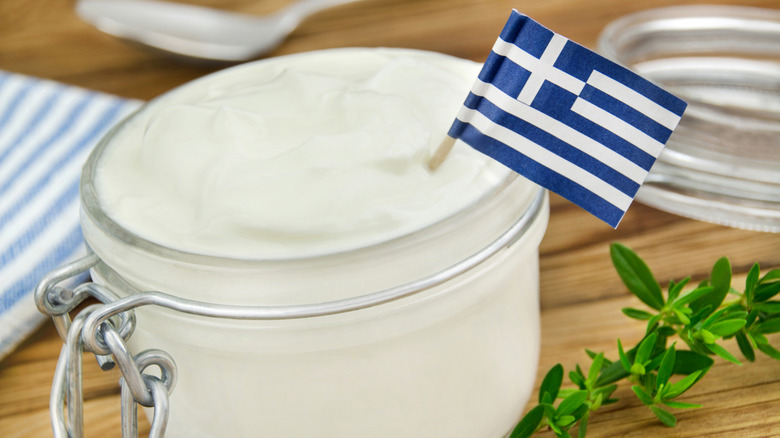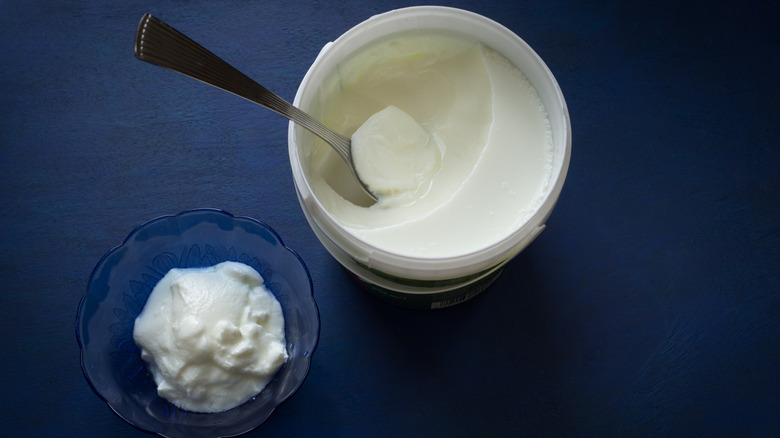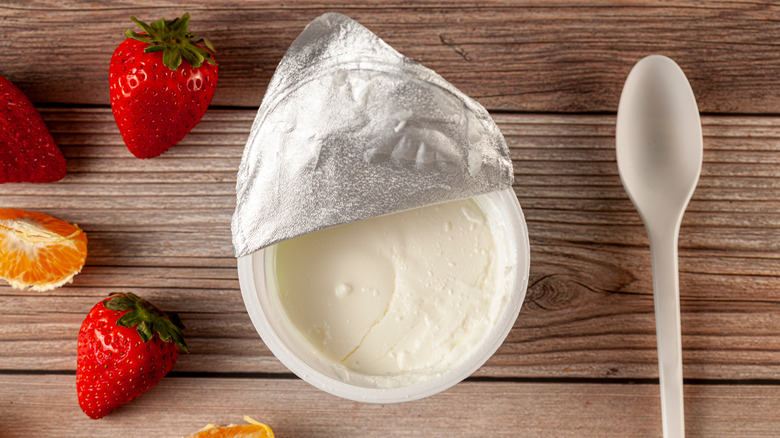Greek Vs Regular Yogurt: Everything You Need To Know
Once you've eaten Greek yogurt in the motherland, there's no going back. You can try to find a match in the U.S. or elsewhere, but it will likely fall short. Why is this? Maybe it's the romance of being in Greece, at the supposed source of this dairy dream. It's hard not to be bowled over when a generous dollop of yogurt arrives at your table post-meal, with honey drizzled on top and a smattering of nuts. (Some of the island restaurants proffer up a free dessert.) It just tastes better on Greek soil. But here's the thing: The Greeks don't call their yogurt "Greek yogurt," and many Greeks actually just eat regular yogurt instead.
What is widely known as Greek yogurt outside of Greece is called straggisto in Greece (strained yogurt). So what sets Greek and regular yogurt apart? It's the straining out of the liquid whey during the production process. Both are made with milk, both have probiotics, both are calcium and protein-rich, and both are easy to include in your daily diet. Let's get into it so you can choose which yogurt you want in your fridge.
What is regular yogurt?
We start here, at the foundation, because Greek yogurt is built on the process of making regular yogurt. It's hard to identify the exact origins of plain yogurt, but there are early records of it across Greece, Turkey, and India. A fermented dairy product called oxygala was consumed by the peasant class in Ancient Greece and mixed with honey. Yogurt is very popular in India, where honeyed yogurt was known as the "food of the gods." It was (and still is) used in Hindu spiritual ceremonies as an offering called Panchamrit. Panchamrit is made using yogurt, honey, milk, and ghee.
Regular yogurt is made from milk. Two healthy bacteria cultures, Lactobacillus bulgaricus and Streptococcus thermophilus, are introduced while making it. The milk is heated to a range of 180 to 200 degrees Fahrenheit, then taken off the heat, kept warm, and allowed to sit at this warm temperature for up to 12 hours. As the milk ferments, it thickens into yogurt with some liquid whey. This whey is not strained out, which is why regular yogurt is more thin. Regular yogurt can be enjoyed in many ways. You can top it with fruit or granola, use it as an addition to smoothies, dollop it on curries or pancakes, mix it into dressings with herbs and spices, and it can even be used to tenderize meat before cooking.
What is Greek yogurt?
Greek yogurt is regular yogurt that has been strained, removing all of the excess liquid whey. This is why Greek yogurt is so creamy, thick, and lip-smackingly satisfying. It's regular yogurt leveled up. Once the milk fermentation has happened in the yogurt-making process, the extra whey is removed using a traditional cloth straining bag (ask any yia yia) or in a factory with centrifuges. The straining of excess liquid and lactose (milk's sugar) makes Greek yogurt thicker, creamier, and less sugary than regular yogurt.
But, again, Greeks don't eat "Greek yogurt." Greek yogurt was a marketing ploy that caught fire when Athens-based Fage, a Greek company, brought its yogurt to the United States. In Greece, what we know as Greek yogurt is called straggisto (strained yogurt), and you can find it in all of the supermarkets over there. "In Greece, to call it Greek yogurt would be like saying 'American hamburger' in the USA or 'British-style fish and chips' in England," Greece travel expert Matt Barrett told Matador Network.
Greek yogurt is higher in protein
If it's protein you're after, switch to Greek yogurt. It contains almost three times the amount of protein that you'll find in regular yogurt. According to Health.com, a 6-ounce container of regular yogurt contains 6 grams of protein while the same size container of Greek yogurt has 17 grams. Dynamite does come in small packages! The other good news is that Greek yogurt is also lower in carbohydrates than regular yogurt, with 3 grams and 8 grams per 6-ounce container, respectively.
You might be a bit confused about the protein stats because plain yogurt still has its whey included. If you've visited your local wellness store recently, the supplement aisle is a popular place for exercise enthusiasts looking for that extra whey protein to boost their muscle growth. This whey is a byproduct of cheese production, rather than yogurt production, and it boasts significantly higher protein content compared to yogurt whey. If you want to pump up your protein game, swap out your regular yogurt for some Greek yogurt goodness.
You can identify each yogurt by its texture
If you had to identify plain and Greek yogurt just by looking at them and spooning them into a bowl, it would be easy to figure out. Plain yogurt is runnier than Greek yogurt because it still has all of the liquid whey in it. Like dense whipped cream, Greek yogurt will stick to the spoon because all of the excess liquid has been strained out.
Even though they're texturally quite different, you can still substitute Greek yogurt for regular yogurt in a recipe; just add a little water or recipe-relevant liquid to maintain moisture levels. You cannot, however, use plain yogurt in a recipe when Greek yogurt is called for because there's no easy way to remove the additional liquid. When you're in the supermarket dairy aisle, remember this — all yogurt is not made equal. It's important to read the ingredient list on labels and note that some brands may call their product Greek yogurt, but they've just added milk proteins or thickening agents to get that iconic texture. Scrutinize the packaging so you know what you're buying is the real deal.
One yogurt is sweeter than the other
Plain yogurt isn't technically sweet — it has a tartness to it. This may be slightly confusing because regular yogurt contains more sugar than Greek yogurt. Healthline did a nutrient comparison between 245 grams of low-fat plain yogurt and low-fat Greek yogurt. What they found is that the plain yogurt contained almost double the amount of sugar that the Greek yogurt contained: Plain had 17 grams of sugar, and Greek yogurt had 9 grams of sugar.
Why such a difference? Since Greek yogurt is strained, some of the lactose gets removed along with the whey. As a result, you end up with a final product that contains less sugar, carbs, and lactose than regular yogurt.
Regular yogurt retains its tang because the acid whey isn't strained out during production. The heat at which yogurt is fermented also affects its tartness. In the yogurt-making process, the final product tends to taste a bit fruitier and tart when made from milk kept below 170 degrees Fahrenheit. Conversely, yogurt made from milk kept at warmer temperatures — around 195 degrees Fahrenheit — turns out thicker with a nuttier, somewhat eggy taste.
The benefits of eating Greek vs regular yogurt
Regular yogurt has more calcium than Greek yogurt because the straining of Greek yogurt removes some of the original calcium. However, in both instances, yogurt is an easy way to get calcium because you don't have to eat as much of it compared to green vegetables. When Healthline compared two 245-gram tubs of plain and Greek yogurt, the plain yogurt had 34% of your recommended daily value (DV) of calcium compared to 22% DV of calcium in Greek yogurt. Plain yogurt also had fewer calories — 154 compared to 179 — and 4 grams of fat compared to Greek yogurt's 5 grams.
The bottom line is you're good if you're eating either. A 2020 study that observed more than 65,000 children and grown-ups found that people who ate yogurt tended to have better diets overall. They consumed more calcium, magnesium, potassium, and vitamin D from their food. The study also showed that those who ate yogurt were more likely to meet the recommended daily intake of these vitamins and minerals compared to those who didn't eat yogurt. A 2020 review of nine studies found that postmenopausal women who regularly consumed yogurt had a reduced risk of hip fractures compared to women who didn't eat yogurt or who had low yogurt consumption.
The true cost of Greek yogurt
Sadly, Greek yogurt production is having a negative environmental impact. When you make Greek yogurt, there is a lot of acid whey as a byproduct. It takes 3 to 4 ounces of milk to make 1 ounce of Greek yogurt, which is an issue in itself; the rest is liquid whey. Unfortunately, this acidic liquid can have catastrophic effects if it is discharged into natural waterways.
In particular, as acid whey decomposes, it removes oxygen from water, which can be devastating to aquatic life. In 2008, an acid whey spill in Ohio killed more than 5,400 wild animals. On a more optimistic note, work is being done to find responsible ways to reuse acid whey. It's been repurposed in animal feed and as a fertilizer, but it can't be eaten en masse and the fertilizer still runs off into waterways. Scientists at the Wisconsin Center for Dairy Research are dedicated to finding a solution. Karen Smith, dairy processing technologist, told Prevention that the organization is looking at ways to break whey down into separate parts — lactose, calcium, and oligosaccharides — which can be used for sweetener syrups, calcium supplements, and as a carbohydrate in infant formulas.
How to use Greek yogurt like the Greeks
Some say the best way to enjoy Greek yogurt is on its own, completely paired down. You want to indulge in its rich and creamy taste and texture, without distraction. Another great way to enjoy Greek yogurt is with a handful of either pistachios or walnuts and a drizzle of honey (don't be shy with the honey). This can be eaten as a breakfast treat or a sweet and simple summer dessert.
Cooking with Greek yogurt should be kept pretty simple. Tzatziki is the Greek dip that many people know of and that's probably because it's easy and delicious. Best of all, you likely have all of the ingredients in the house for an easy tzatziki recipe (yogurt, cucumber, garlic, lemon, and dill). Make sure you deseed the cucumber first before grating it, otherwise your dip will be very watery. Serve it with a mezze platter, fresh pita, or as a side to a lamb dish. This is one sure way to knock the socks off your friends the next time they come around for a summer barbecue.
How to use regular yogurt like a boss
Plain yogurt. It sits in the fridge as a breakfast staple and doesn't get used for much else. But have you ever baked with yogurt? It brings a delicious flavor and moistness to cakes, muffins, and the like. Try out this yogurt cake recipe and see if you agree. It has apple and pear in it, too. Did someone say tea time?
Another innovative way to use plain yogurt is as a marinade for chicken. The enzymes in the yogurt tenderize the chicken, making it softer and more juicy. If you add herbs and spices, like oregano, thyme, smoked paprika, or cayenne to the yogurt, you can get the flavor profile you're after. How about a simple, nutrient-packed sweet treat? These frozen yogurt cookies are full of protein, healthy fats, and gut-friendly probiotics. Dip them in chocolate at the end and top with chia seeds, shredded coconut, crushed nuts, or whatever else your heart desires.










